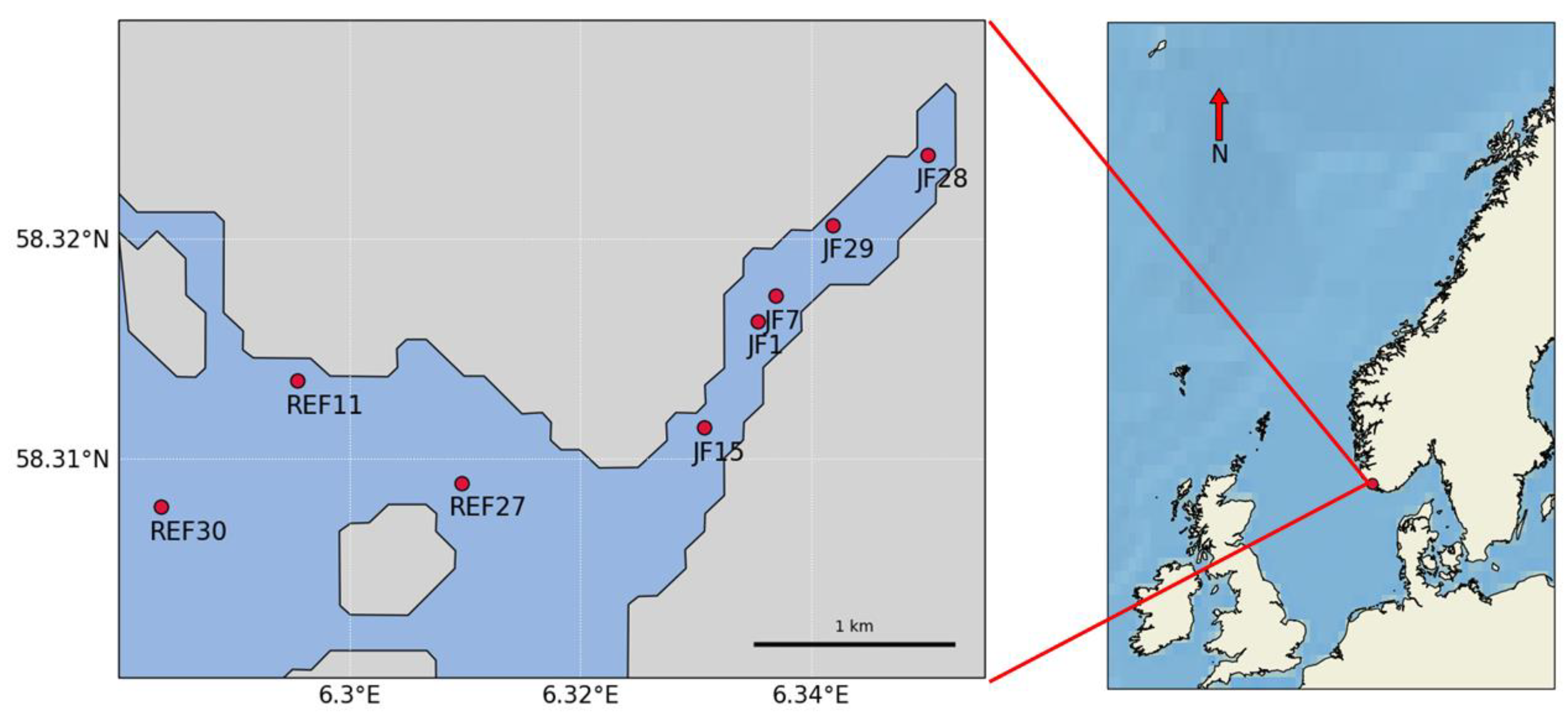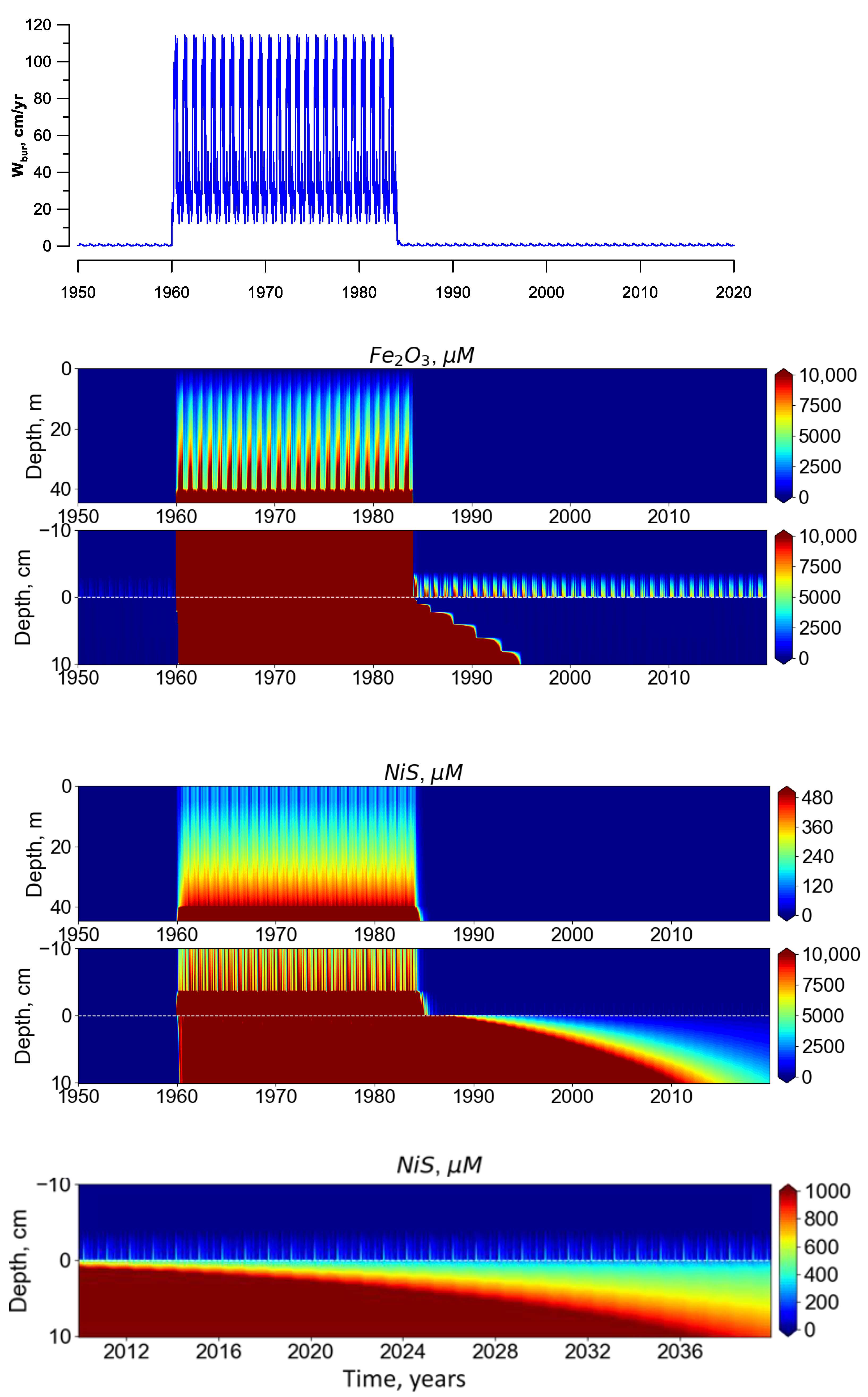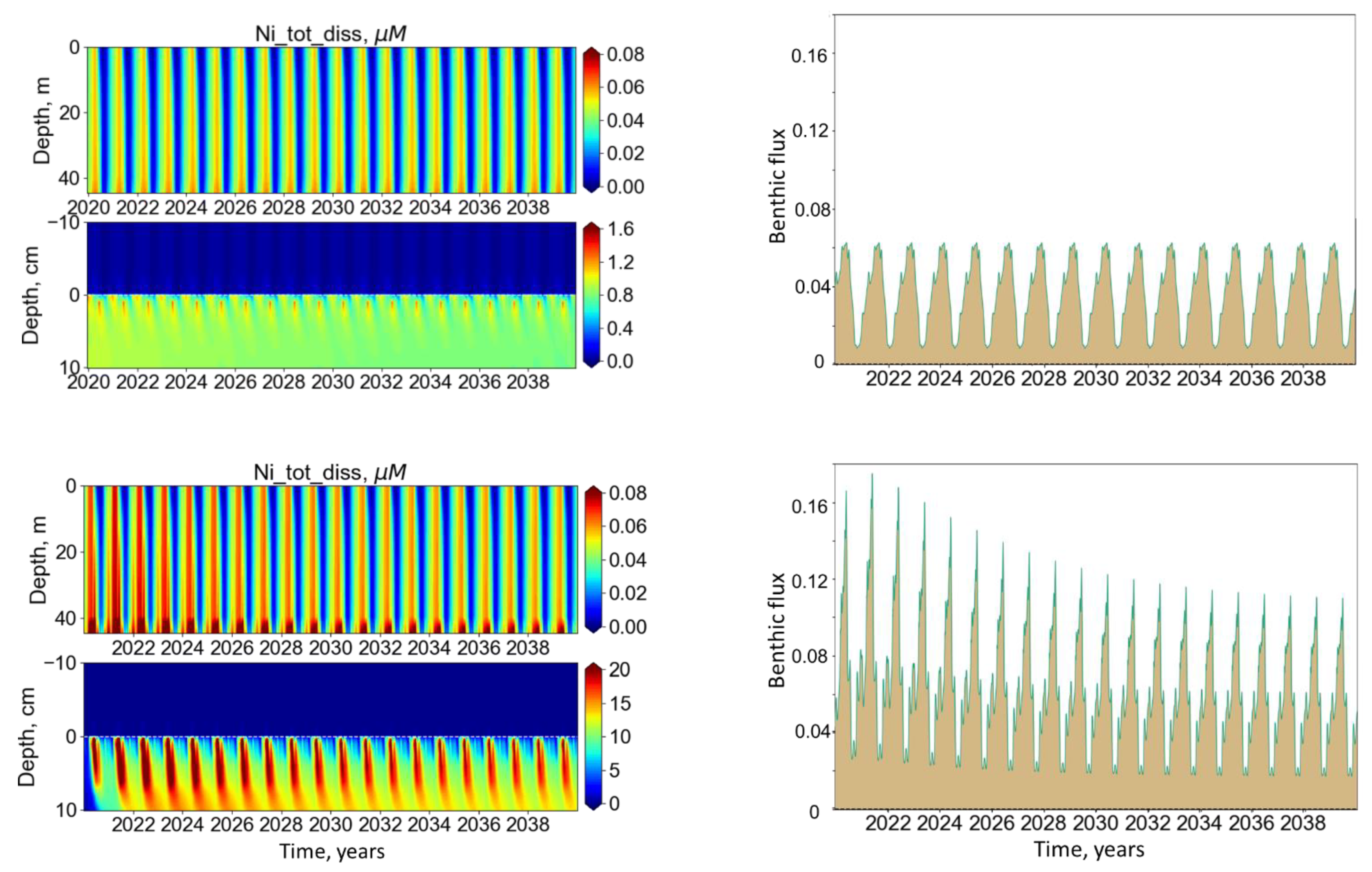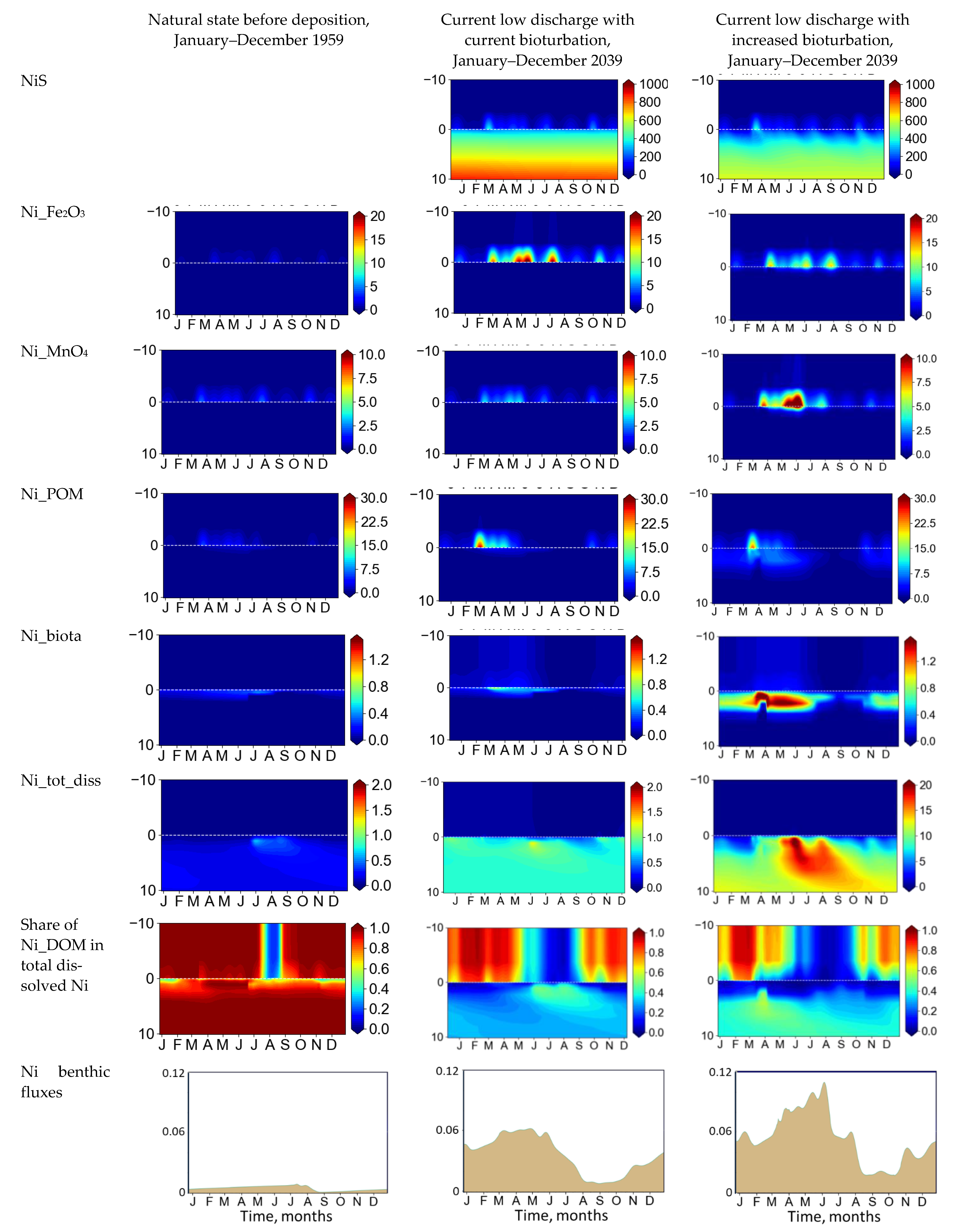Modeling Nickel Leaching from Abandoned Mine Tailing Deposits in Jøssingfjorden
Abstract
:1. Introduction
2. Materials and Methods
2.1. Model Description
2.2. Boundary Conditions
2.3. Hydrophysics
2.4. Forcing
2.4.1. Water Column
2.4.2. Sediment
2.4.3. Tailings
2.5. Scenarios
- Total cessation of mine tailing deposition into the fjord in 2030.
- Doubling of the intensity of mine tailing deposition into the fjord in 2030.
- Increased bioturbation activity from 2020. Bioturbation activity was changed by an increase in parameters of sediment diffusivity (Table 1).
3. Results
3.1. Simulated Interannual Variability
3.2. Comparison with the Field Data
3.2.1. Porewater Concentrations
3.2.2. Benthic Fluxes
3.2.3. Ni in Sediment
3.3. Numerical Experiments
3.3.1. Total Cessation of All Discharge of Mine Tailings
3.3.2. Doubling of Deposition Intensity
3.3.3. Increase in Bioturbation Activity
4. Discussion
4.1. Ni Species Fate
4.2. Environmental Status of Water and Sediment in Jøssingfjord for Different Scenarios
5. Conclusions
Author Contributions
Funding
Data Availability Statement
Acknowledgments
Conflicts of Interest
References
- Koski, R.A. Metal Dispersion Resulting from Mining Activities in Coastal Environments: A Pathways Approach. Oceanography 2012, 25, 170–183. [Google Scholar] [CrossRef]
- Ramirez-Llodra, E.; Trannum, H.C.; Evenset, A.; Levin, L.A.; Andersson, M.; Finne, T.E.; Hilario, A.; Flem, B.; Christensen, G.; Schaanning, M.; et al. Submarine and deep-sea mine tailing placements: A review of current practices, environmental issues, natural analogs and knowledge gaps in Norway and internationally. Mar. Pollut. Bull. 2015, 97, 13–35. [Google Scholar] [CrossRef]
- Reichl, C.; Schatz, M.; Zsak, G. World-Mining-Data. Miner. Prod. Inter Natl. Organ. Comm. World Min. Congr. 2014, 32, 1–261. [Google Scholar]
- Hudson-Edwards, K.A.; Dold, B. Mine Waste Characterization, Management and Remediation. Minerals 2015, 5, 82–85. [Google Scholar] [CrossRef] [Green Version]
- Arnesen, R.T.; Bjerkeng, B.; Iversen, E.R. Comparison of model predicted and measured copper and zinc concentrations at three Norwegian underwater tailings disposal sites. In Proceedings of the Fourth International Conference on Acid Rock Drainage, Vancouver, BC, Canada, 31 May–6 June 1997; Volume 4, pp. 1831–1847. [Google Scholar]
- Dold, B. Evolution of Acid Mine Drainage Formation in Sulphidic Mine Tailings. Minerals 2014, 4, 621–641. [Google Scholar] [CrossRef] [Green Version]
- Dold, B. Submarine tailings disposal (STD)—A review. Minerals 2014, 4, 642–666. [Google Scholar] [CrossRef]
- Simpson, S.L.; Spadaro, D.A. Bioavailability and Chronic Toxicity of Metal Sulfide Minerals to Benthic Marine Invertebrates: Implications for Deep Sea Exploration, Mining and Tailings Disposal. Environ. Sci. Technol. 2016, 50, 4061–4070. [Google Scholar] [CrossRef]
- Schippers, A. Biogeochemistry of metal sulfide oxidation in mining environments, sediments, and soils. In Sulfur Biogeochemistry—Past and Present; Geological Society of America Special Paper; Amend, J.P., Edwards, K.J., Lyons, T.W., Eds.; Geological Society of America: Boulder, CO, USA, 2004; Volume 379, pp. 49–62. [Google Scholar]
- Schaanning, M.T.; Trannum, H.C.; Pinturier, L.; Rye, H. Metal Partitioning in Ilmenite- and Barite-Based Drill Cuttings on Seabed Sections in a Mesocosm Laboratory. SPE Drill. Complet. 2011, 26, 268–277. [Google Scholar] [CrossRef]
- Koski, R.A.; Munk, L.; Foster, A.L.; Shanks, W.C.; Stillings, L.L. Sulfide oxidation and distribution of metals near abandoned copper mines in coastal environments, Prince William Sound, Alaska, USA. Appl. Geochem. 2008, 23, 227–254. [Google Scholar] [CrossRef]
- Amato, E.D.; Simpson, S.L.; Remaili, T.M.; Spadaro, D.A.; Jarolimek, C.V.; Jolley, D.F. Assessing the Effects of Bioturbation on Metal Bioavailability in Contaminated Sediments by Diffusive Gradients in Thin Films (DGT). Environ. Sci. Technol. 2016, 50, 3055–3064. [Google Scholar] [CrossRef]
- Mil-Homens, M.; Vale, C.; Naughton, F.; Brito, P.; Drago, T.; Anes, B.; Raimundo, J.; Schmidt, S.; Caetano, M. Footprint of roman and modern mining activities in a sediment core from the southwestern Iberian Atlantic shelf. Sci. Total Environ. 2016, 571, 1211–1221. [Google Scholar] [CrossRef]
- Simpson, S.L.; Apte, S.C.; Batley, G.E. Effect of Short-Term Resuspension Events on Trace Metal Speciation in Polluted Anoxic Sediments. Environ. Sci. Technol. 1998, 32, 620–625. [Google Scholar] [CrossRef]
- Berg, B.I.; Sæland, F.; Nyland, A.J.; Østensen, P.Ø.; Nordrum, F.S.; Kullerud, K. Bergverk i Norge; Fagbokforl: Bergen, Norway, 2016. [Google Scholar]
- Kvassnes, A.J.S.; Iversen, E. Waste sites from mines in Norwegian fjords. Mineralproduksjon 2013, 3, A27–A38. [Google Scholar]
- Nordgulen, Ø.; Andersen, A. Jordas Urtid–De Eldste Bergarter Dannes: 4600–850 MA; Ramberg, B., Bryhni, I., Nøttevedt, A., Eds.; Norges Geologi: Trondheim, Norway, 2007; pp. 107–108. [Google Scholar]
- Bjerkgard, T.; Boyd, R.; Ihlen, P.; Korneliussen, A.; Nilsson, L.P.; Often, M.; Sandstad, j.; Eilu, P.; Hallberg, A. Metallogenic areas in Norway. Geol. Surv. Finl. 2012, 53, 35–138. [Google Scholar]
- Schärer, U.; Wilmart, E.; Duchesne, J.C. The short duration and anorogenic character of anorthosite magmatism: U-Pb dating of the Rogaland complex, Norway. Earth Planet. Sci. Lett. 1996, 139, 35–350. [Google Scholar] [CrossRef]
- Charlier, B.; Skår, Ø.; Korneliussen, A.; Duchesne, J.-C.; Auwera, J.V. Ilmenite composition in the Tellnes Fe–Ti deposit, SW Norway: Fractional crystallization, postcumulus evolution and ilmenite–zircon relation. Contrib. Miner. Pet. 2007, 154, 119–134. [Google Scholar] [CrossRef]
- Duchesne, J.C.; Schiellerup, H. The iron-titanium deposits. In The Rogaland Intrusive Massifs: An Excursion Guide; NGU Report 2001.29; Duchesne, J.C., Ed.; Norges Geologiske Undersøkelse: Trondheim, Norway, 2001; pp. 56–75. [Google Scholar]
- Anon. Titania A/S–Proposal for Monitoring Program. Geode Consult AS, P.O. Box 97, 1378 Nesbu. 2015. [Google Scholar]
- Sørby, H.; Storbråten, G.; Braastad, G.; Løkeland, M. Bergverk og Avgangsdeponering. In Status, Miljøutfordringer og Kunnskapsbehov; Klif report TA2715/2010; Klima-og Forurensningsdirektoratet: Oslo, Norway, 2010. [Google Scholar]
- Schaanning, M.T.; Trannum, H.C.; Øxnevad, S.; Ndungu, K. Benthic community status and mobilization of Ni, Cu and Co at abandoned sea deposits for mine tailings in SW Norway. Mar. Pollut. Bull. 2019, 141, 318–331. [Google Scholar] [CrossRef] [PubMed]
- Fauske, L.L. Transport of Heavy Metals from Mine Waste of Titania. Master’s Thesis, University of Oslo, Oslo, Norway, 2017. [Google Scholar]
- Yakushev, E.V.; Protsenko, E.A.; Bruggeman, J.; Wallhead, P.; Pakhomova, S.V.; Yakubov, S.K.; Bellerby, R.G.J.; Couture, R.-M. Bottom RedOx Model (BROM v.1.1): A coupled benthic–pelagic model for simulation of water and sediment biogeochemistry. Geosci. Model Dev. 2017, 10, 453–482. [Google Scholar] [CrossRef] [Green Version]
- Bruggeman, J.; Bolding, K. A general framework for aquatic biogeochemical models. Environ. Model. Softw. 2014, 61, 249–265. [Google Scholar] [CrossRef] [Green Version]
- Butenschön, M.; Clark, J.; Aldridge, J.N.; Allen, J.I.; Artioli, Y.; Blackford, J.; Bruggeman, J.; Cazenave, P.; Ciavatta, S.; Kay, S.; et al. ERSEM 15.06: A generic model for marine biogeochemistry and the ecosystem dynamics of the lower trophic levels. Geosci. Model Dev. 2016, 9, 1293–1339. [Google Scholar] [CrossRef] [Green Version]
- Katsev, S.; Sundby, B.; Mucci, A. Modeling vertical excursions of the redox boundary in sediments: Application to deep basins of the Arctic Ocean. Limnol. Oceanogr. 2006, 51, 1581–1593. [Google Scholar] [CrossRef] [Green Version]
- Shchepetkin, A.F.; McWilliams, J.C. The regional oceanic modeling system (ROMS): A split-explicit, free-surface, topography-following-coordinate oceanic model. Ocean Model. 2005, 9, 347–404. [Google Scholar] [CrossRef]
- Gravdal, J.K.S. Stability of Heavy Metals in Submarine Mine Tailings: A Geochemical Study. Master’s Thesis, University of Bergen, Bergen, Norway, 2013. [Google Scholar]
- Mellgren, A. Dissolved Nickel in the Lundetjern land Deposit-Identification of Main Causes and Methods for Treatment. Master’s Thesis, Norwegian University of Science and Technology, Trondheim, Norway, 2002. [Google Scholar]
- Soetaert, K.; Middelburg, J.J. Modeling eutrophication and oligotrophication of shallow-water marine systems: The importance of sediments under stratified and well-mixed conditions. In Eutrophication in Coastal Ecosystems; Springer: Berlin/Heidelberg, Germany, 2009; pp. 239–254. [Google Scholar]
- Pakhomova, S.V.; Hall, P.O.; Kononets, M.Y.; Rozanov, A.G.; Tengberg, A.; Vershinin, A.V. Fluxes of iron and manganese across the sediment–water interface under various redox conditions. Mar. Chem. 2007, 107, 319–331. [Google Scholar] [CrossRef]
- Canfield, D.E.; Thamdrup, B.; Hansen, J.W. The anaerobic degradation of organic matter in Danish coastal sediments: Iron reduction, manganese reduction, and sulfate reduction. Geochim. Cosmochim. Acta 1993, 57, 3867–3883. [Google Scholar] [CrossRef]
- Silverberg, N.; Sundby, B. Sediment-Water Interaction and Early Diagenesis in the Laurentian Trough. In Oceanography of a Large-Scale Estuarine System; Springer: Berlin/Heidelberg, Germany, 1990; pp. 202–238. [Google Scholar]
- Veileder 02:2018 Klassifisering av Miljøtilstand i vann. Økologisk og Kjemisk Klassifiseringssystem for Kystvann, Grunnvann, Innsjøer og Elver. Direktoratsguppen Vanndirektivet. 2018. Available online: https://www.vannportalen.no/veiledning/klassifiserings/ (accessed on 1 February 2021).








| . | Basic Scenario | Increased Bioturbation Scenario |
|---|---|---|
| kz_bioturb_max, m2/s | 1 × 10−11 | 20 × 10−11 |
| z_const_bioturb, m | 0.0001 | 0.01 |
| z_decay_bioturb, m | 0.01 | 0.1 |
| Condition | Class I Background “Very Good” | Class II AA-EQS “Good” | Class III Mac-EQS “Moderate” | Class IV “Poor” | Class V “Very Poor” |
|---|---|---|---|---|---|
| Coastal water, μg/L (μM) | <0.5 (0.01) | 0.5–8.6 (0.01–0.15) | 8.6–34 (0.15–0.58) | 34–67 (0.58–1.14) | >67 (1.14) |
| Sediment, mg/kg | <30 | 30–42 | 42–271 | 271–533 | >533 |
| Water column | NS | CLD, CLDib | ID | ||
| BBL (water) | NS | CLD | CLDib | ID | |
| Porewater | NS | CLD | CLDib | ||
| Sediment | NS | CLDib | CLD | ID |
Publisher’s Note: MDPI stays neutral with regard to jurisdictional claims in published maps and institutional affiliations. |
© 2021 by the authors. Licensee MDPI, Basel, Switzerland. This article is an open access article distributed under the terms and conditions of the Creative Commons Attribution (CC BY) license (https://creativecommons.org/licenses/by/4.0/).
Share and Cite
Pakhomova, S.; Yakushev, E.; Schaanning, M.T. Modeling Nickel Leaching from Abandoned Mine Tailing Deposits in Jøssingfjorden. Water 2021, 13, 967. https://doi.org/10.3390/w13070967
Pakhomova S, Yakushev E, Schaanning MT. Modeling Nickel Leaching from Abandoned Mine Tailing Deposits in Jøssingfjorden. Water. 2021; 13(7):967. https://doi.org/10.3390/w13070967
Chicago/Turabian StylePakhomova, Svetlana, Evgeniy Yakushev, and Morten Thorne Schaanning. 2021. "Modeling Nickel Leaching from Abandoned Mine Tailing Deposits in Jøssingfjorden" Water 13, no. 7: 967. https://doi.org/10.3390/w13070967
APA StylePakhomova, S., Yakushev, E., & Schaanning, M. T. (2021). Modeling Nickel Leaching from Abandoned Mine Tailing Deposits in Jøssingfjorden. Water, 13(7), 967. https://doi.org/10.3390/w13070967







